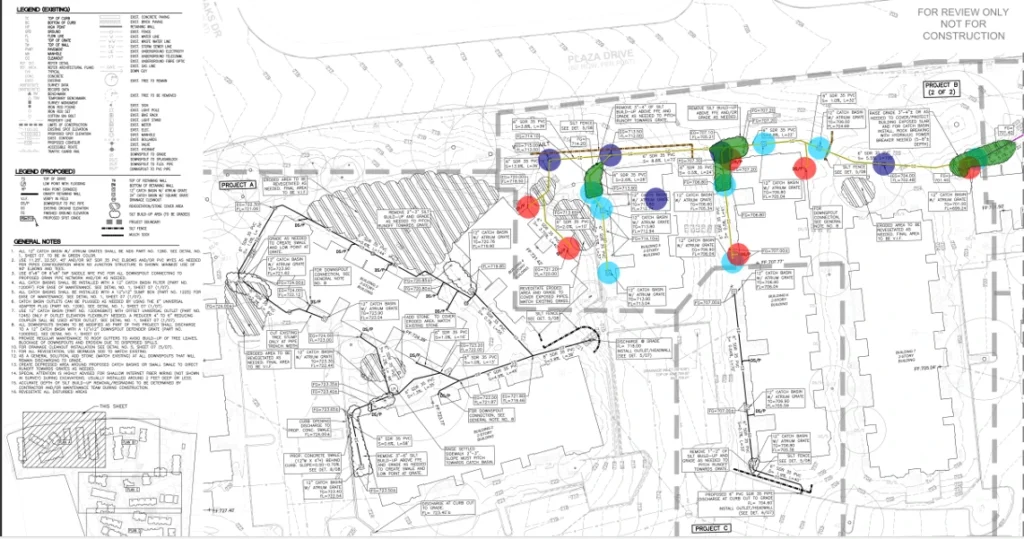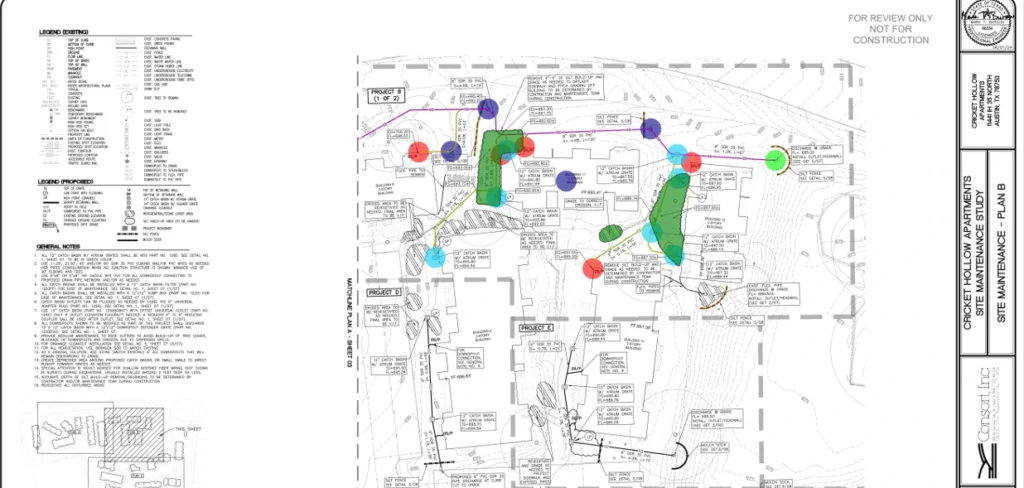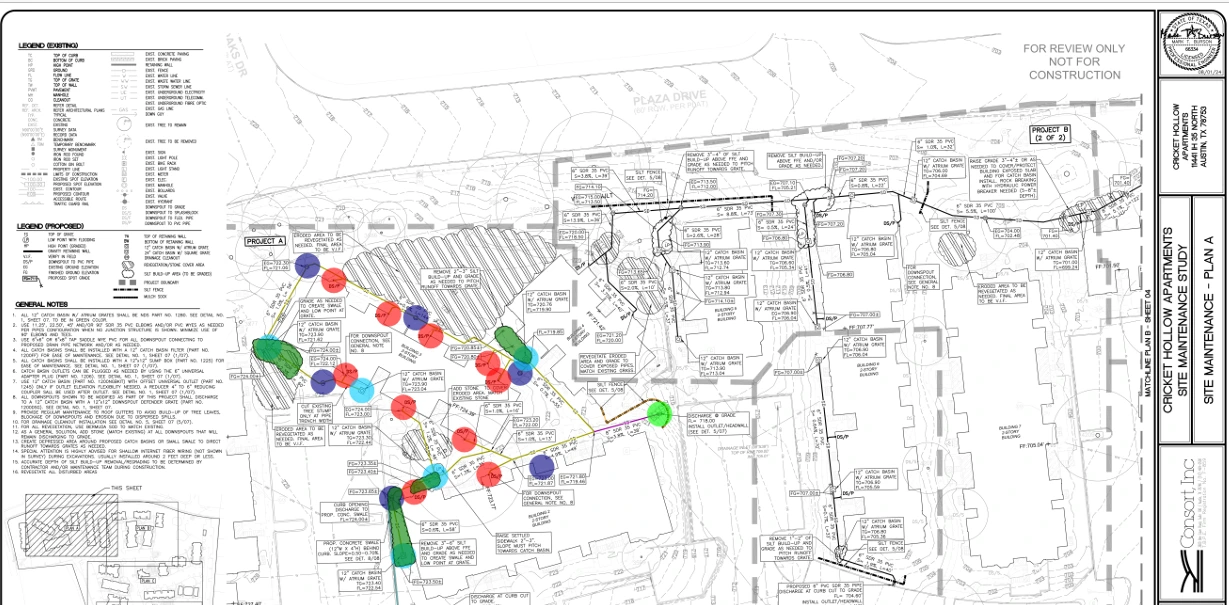Cricket Hollow Apartments Estimation – Austin, TX
Upgrading a property isn’t just about construction—it’s about safeguarding a community’s future. At Cricket Hollow Apartments in Austin, TX, a multi-phase site maintenance project is doing exactly that. By redesigning storm drainage, grading, and utility systems, this development isn’t only about pipes and pavement; it’s about protecting homes, improving livability, and ensuring resilience for years to come. For client Stephen, the challenge goes beyond budgets and blueprints—it’s about navigating the real complexities of urban infrastructure, where every decision affects both cost and community well-being.
Table of Contents
Site Maintenance Meets Infrastructure Modernization
At its heart, this isn’t just another maintenance project—it’s a transformation. The Circket Hollow Apartments site demands more than patchwork fixes; it needs a complete reimagining of how water, land, and infrastructure work together. Every detail, from trenching and utility installation to erosion control and concrete renewal, is part of a larger mission: to protect the property, safeguard its residents, and build a stronger, more resilient community for the future.
Breaking a project into phases isn’t just a construction strategy—it’s a way to bring order to chaos. At cricket Hollow Apartments, the multi-phase approach gives breathing room to budgets, eases cash flow pressures, and allows for careful checks at every stage. It’s a smarter, steadier path forward. Yet, with every pause and restart comes added strain: repeated mobilizations, intricate sequencing, and the reality of longer timelines. It’s a balance between control and complexity—one that tests both patience and planning.

Key Construction Components
Storm Drainage Infrastructure
The most critical part of this project is building a stormwater defense system that stands as a guardian against heavy rains, protecting not just the property but the safety and peace of mind of everyone who lives nearby.
- 6-inch SDR PVC pipelines: Ranging between 338.5 and 594.8 linear feet across different phases.
- 8-inch SDR PVC pipelines: Larger capacity piping spanning 32.3 to 308.8 feet.
- Drain boxes with metal grates: Between 5 and 8 units per phase.
- Downspout connections: Multiple links to connect building drainage into the main system.
This network is the unseen backbone of the community’s protection, quietly channeling stormwater away from homes, walkways, and parking areas—keeping foundations strong, daily life uninterrupted, and residents safe no matter how hard the rain falls.
Site Work & Earthwork
Beyond managing stormwater, the land itself must be reshaped and strengthened. Careful grading and earthwork will transform uneven ground into a stable foundation for the future. Old concrete will be removed and replaced, while new swales are carved with precision to guide water safely away. Every square foot of soil moved and every slab of concrete replaced is more than construction—it’s laying the groundwork for a safer, stronger community.
Earthwork Shapes the Project
Earthwork is where the ground itself decides the pace of progress. The stability of the soil, its moisture, and its strength determine how quickly foundations can be secured. In a busy city like Austin, even moving equipment through tight spaces or finding a place for excavated soil adds pressure to both time and budget. Every shovel of earth carries weight—not just in cost, but in how smoothly the entire project moves forward.

Utility Infrastructure & Environmental Compliance
Building with Foresight
One of the most critical aspects of this project is the way planning meets precision. By carefully reviewing materials, labor needs, and phasing strategies, contractors aren’t just crunching numbers—they’re shaping a roadmap that ensures stability, safety, and long-term value.
Materials That Matter
Every pipe, every structure, and every slab of concrete plays a role far greater than its physical form. The piping channels life through the site, drainage structures protect families and businesses from flooding, and concrete pathways create durable spaces where people can safely walk and gather.
The Groundwork of Trust
Grading and earthwork aren’t just about reshaping soil—they’re about preparing the land to hold strong for generations. Every adjustment, every layer of compaction is a promise that the site will endure, resisting time and weather so the community can thrive without worry.
Labor Considerations
Behind every pipe laid and every trench dug is the strength and dedication of skilled crews working in harmony. Excavators shape the land, utility teams carefully guide water to safer paths, and restoration crews give the site its finished form. It’s more than just tasks—it’s precision, teamwork, and pride. The final touches in grading and paving aren’t just about durability; they’re about creating safe, lasting spaces where communities can grow with confidence.
Project Phasing A Double-Edged Sword
The multi-phase approach offers several advantages:
- Improved cash flow management.
- Reduced risk exposure by isolating challenges phase by phase.
- Easier inspection and permitting processes.
The Challenge of Building in Phases
Breaking a project into phases offers control and flexibility, but it also tests patience and coordination. Each stage means new crews, shifting equipment, and extended traffic adjustments that touch the daily lives of nearby residents. In a busy urban setting, every delay or overlap isn’t just a scheduling issue—it’s a ripple that impacts how quickly communities can reclaim safe, accessible spaces.
Critical Cost Factors That Influence the Budget
Even with the most detailed drawings and carefully mapped plans, real-world projects rarely unfold in a perfect straight line. Surprises beneath the soil, unexpected utility conflicts, or weather shifts can quickly reshape the path from design to delivery. At Cricket Hollow Apartments, success depends on anticipating these twists and turns—because every challenge faced isn’t just about the budget, it’s about protecting timelines, safety, and the community that calls this place home.
Site Conditions
Beneath the surface lies the greatest unknown. The soil can either be a silent ally or a hidden adversary. If it’s unstable, waterlogged, or layered with stubborn rock, progress slows to a crawl. And when contamination is discovered, it’s not just a technical hurdle—it’s a reminder that safety and environmental care must come before speed.
Existing Utilities
Urban ground is never truly empty. Buried gas lines, electrical conduits, and telecom cables form an invisible web beneath Austin’s streets. Each discovery brings tension—one wrong move could disrupt entire neighborhoods and drain budgets fast. That’s why integrating MEP estimation into early planning is crucial. By mapping utilities and forecasting mechanical, electrical, and plumbing costs upfront, developers and contractors can anticipate risks, prevent costly surprises, and keep projects moving with confidence.
Access Constraints
In a tight apartment community, there’s no wide-open field to work with. Every turn of a crane or rumble of an excavator must be carefully choreographed to avoid disrupting daily life. Crews often rely on smaller machines and creative staging, which stretches timelines. It’s not just about moving equipment—it’s about residents’ space while transforming it.
Regulatory Compliance
Every permit pulled and every inspection passed tells a story of accountability. Stormwater checks, safety audits, and municipal reviews may feel like hurdles, but they serve a higher purpose: protecting families, preserving the environment, and ensuring the project stands the test of time. Compliance here isn’t a box to tick—it’s a promise to the community.
Budget Recommendations for Better Control
Cost overruns are the storm clouds of site development—but they don’t have to define the project. With smart urban planning, Cricket Hollow Apartments can turn uncertainty into confidence, keeping progress steady and the community’s trust intact.
- Contingency Planning
Think of this as the safety net beneath the tightrope. Setting aside 15–20% ensures that when hidden debris, sudden storms, or unexpected delays appear, the project keeps moving without panic. - Escalation Allowances
Materials like PVC and concrete don’t wait for stability—they rise and fall with the market. By locking in bulk orders early, contractors protect the project from price shocks and keep progress on steady ground. - Change Order Reserve
Every phase uncovers new realities beneath the soil. Having a reserve ready means surprises don’t stall progress or drain resources—it keeps crews confident and schedules intact. - Value Engineering Opportunities
True efficiency isn’t about cutting corners, it’s about smarter choices. Exploring alternative materials or adjusting phasing can ease traffic impacts and reduce waste, while still delivering durability the community can rely on.
Risk Management in Multi-Phase Site Development
Success here means planning for the unseen. Hidden gas, water, or telecom lines beneath the surface can derail progress overnight. By using advanced surveys and ground-penetrating radar, the team safeguards both the project and the daily lives of residents who depend on these utilities.
Utility Conflicts
Beneath the ground lies a hidden maze of gas, water, and telecom lines. Striking one can halt progress and disrupt lives. Detailed surveys and ground-penetrating radar help uncover these risks before the first shovel breaks soil.
Weather Delays
Austin’s sudden downpours can turn open trenches into hazards overnight. Flexible scheduling, solid trench protection, and erosion controls keep work moving and residents safe from storm impacts.
Coordination Complexity
When multiple crews and inspectors overlap, even small missteps can ripple through the schedule. Clear communication, digital project tools, and careful sequencing keep every phase aligned like clockwork.
Environmental Compliance
Stormwater rules aren’t just paperwork—they safeguard the community’s health and the site’s future. Consistent erosion controls and vigilant inspections ensure progress continues without costly setbacks.
Conclusion
The Cricket Hollow Apartments project is more than construction—it’s a promise of safety, strength, and long-term resilience for the community it serves. By rethinking drainage, reshaping the land, and managing risks with care, this development shows how thoughtful planning turns challenges into lasting solutions. For developers and property managers, the lesson is clear: with vision and coordination, even the toughest urban projects can create value that endures for decades.

